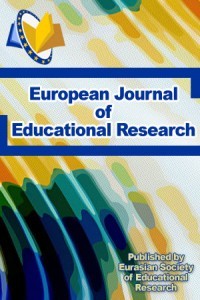Measuring Literary Reading Motivation: Questionnaires Design and Pilot Testing
Measuring Literary Reading Motivation: Questionnaires Design and Pilot Testing
Literary reading, self-efficacy, intrinsic motivation, measurement 6 graders,
___
- Alexander, P. (2005). The path to competence: A lifespan developmental perspective on reading. Journal of Literacy Research, 37, 413–436.
- Alvermann, D. E., & Guthrie, J. T. (1993). Themes and directions of the National Reading Research Center. Perspectives in Reading Research, 1, 1-11.
- Babalis, T., Galanaki, Ε., & Stavrou, Ν. Α. (2007). Η ζωή στη σχολική τάξη: Σύνδεσμοι μεταξύ υποστήριξης, συνεργασίας και σχολικής αυτοεκτίμησης [Life in classroom: Relations among support, collaboration and school self-esteem]. Επιστήμες Αγωγής, 2, 35-50.
- Baker, L. & Wigfield, A. (1999). Dimensions of children’s motivation for reading and their relations to reading activity and reading achievement. Reading Research Quarterly, 34, 452-477.
- Bandura, A. (1995). Self-efficacy in changing societies. New York, NY: Cambridge University Press.
- Bandura, A. (2006). Guide for constructing self-efficacy scales. In F. Pajares & T. Urdan, (Eds.), Self-Efficacy Beliefs of Adolescents (pp. 307-337). Greenwich, CT: Information Age Publishing
- Bong, M., & Skaalvik, E. M. (2003). Academic self-concept and self-efficacy: How different are they really? Educational Psychology Review, 15(1), 1-40.
- Cohen, L. & Manion, L. (1994). Μεθοδολογία εκπαιδευτικής έρευνας [Educational research methodology] (Χ. Μητσοπούλου & Μ. Φιλοπούλου, μτφρ.). Αθήνα: Μεταίχμιο.
- Csikszentmihalyi, M. (1990). Flow: The psychology of optimal experience. New York, NY: Harper Perennial.
- Deci, E., & Ryan, R. (1985). Intrinsic motivation and self-determination in human behavior. New York, NY: Plenum.
- Deci, E. L., & Ryan, R. M. (2000). The ‘what’ and ‘why’ of goal pursuits: Human needs and the self‐determination of behaviour. Psychological Inquiry, 11(4), 227‐268.
- Deci, E. L., Ryan, R. M., Gagne, M., Leone, D. R., Usunov, J., & Kornazheva, B. P. (2001). Need satisfaction, motivation, and well-being in the work organizations of a former eastern bloc country: A cross-cultural study of self-determination. Personality and Psychology Bulletin, 27(8), 930–942.
- Gambrell, L.B., Palmer, B.M., Codling, R.M., & Mazzoni, S.A. (1996). Assessing motivation to read. The Reading Teacher, 49(7), 518–533.
- Guthrie, J., & Wigfield, A. (2000). Engagement and motivation in reading. In M. Kamil, P. Mosenthal, P. Pearson, & R. Barr (Eds.), Handbook of reading research (3rd ed.) (pp. 403-422). New York, NY: Longman.
- Guthrie, J. T., McRae, A., & Klauda, S.L. (2007). Contributions of concept-oriented reading instruction to knowledge about interventions for motivations in reading. Educational Psychologist, 42(4), 237-250.
- Henk, W. A., & Melnick, S. A. (1995). The Reader Self-Perception Scale (RSPS): A new tool for measuring how children feel about themselves as readers. The Reading Teacher, 48(6), 470-482.
- Jackson, S.A., & Marsh, H.W. (1995). Development and validation of a scale to measure optimal experience: The Flow State Scale. Journal of Sport and Exercise Psychology, 18, 17-35.
- Kambaki-Vougioukli, P., & Vougiouklis, T . (2008). Bar instead of scale. Ratio Sociologica, 3, 49-56.
- Lapp, D., & Fisher, D. (2009). It’s all about the book: Motivating teens to read. Journal of Adolescent & Adult Literacy, 52(7), 556-561.
- McAuley, E., Duncan, T., & Tammen, V. (1989). Psychometric properties of the Intrinsic Motivation Inventory in a competitive sport setting: A confirmatory factor analysis. Research Quarterly for Exercise and Sport, 60(1), 48-58.
- Niemiec, C. P., & Ryan, R. M. (2009). Autonomy, competence, and relatedness in the classroom; Applying self-determination theory to educational practice. Theory and Research in Education, 7(2), 133-144.
- Pajares, F., Hartley, J., & Valiante, G. (2001). Response format in writing self-efficacy assessment: Greater discrimination increases prediction. Measurement and Evaluation in Counseling and Development, 33, 214-221.
- Pajares, F. (2006). Self-efficacy during childhood and adolescence. In F. Pajares & T. Urdan (Eds.), Self-efficacy beliefs of adolescents (pp. 339-367). Greenwich, CT: Information Age Publishing.
- Pintrich, P. R., & Schunk, D. H. (2002). Motivation in education: Theory, research, and applications (2nd ed.). Upper Saddle River, NJ: Prentice Hall.
- Ryan, R. M., & Deci, E. L. (2000). Self-determination theory and the facilitation of intrinsic motivation, social development, and well-being. American Psychologist, 55(1), 68-78.
- Richer, S., & Vallerand, R. J. (1998). Construction and validation of the Perceived Relatedness Scale. Revue Européene de Psychologie Appliquée, 48, 129-137.
- Schunk, D. H., & Rice, J. M. (1993). Strategy fading and progress feedback: Effects on self-efficacy and comprehension among students receiving remedial reading services. Journal of Special Education, 27(3), 257–276.
- Schunk, D. H., & Pajares, F. (2002). The development of academic self-efficacy. In A. Wigfield, & J. S. Eccles, (Eds.), Development of achievement motivation (pp. 16-32). San Diego, CA: Academic Press.
- Walker, B. (2003). The cultivation of student self-efficiency in reading and writing. Reading and Writing Quarterly, 19(2), 173–187.
- Wigfield, A., Eccles, J.. S., & Pintrich, P. (1996). Development between the ages of eleven and twenty-five. In D.C. Berliner, & R.C. Calfee (Eds.), The Handbook of Educational Psychology, New York, NY: Macmillan Publishing.
- Wigfield, A., & Guthrie, J.T. (1997). Relations of children’s motivation for reading to the amount and breadth of their reading. Journal of Educational Psychology, 89(3), 420-432.
- Wigfield, A., Guthrie, J. T., Tonks, S., & Perencevich, K. C. (2004). Children's motivation for reading: Domain specificity and instructional influences. The Journal of Educational Research, 97(6), 299-309.
- ISSN: 2165-8714
- Başlangıç: 2012
- Yayıncı: Eurasian Society of Educational Research
Maria Guadalupe VİLLARREAL-TREVİÑO, Ricardo Jesus VİLLARREAL-LOZANO, Guadalupe Elizabeth MORALES-MARTİNEZ, Ernesto Octavio LOPEZ-RAMİREZ, Norma Esthela FLORES-MORENO
Measuring Literary Reading Motivation: Questionnaires Design and Pilot Testing
Silke RUPPRECHT, Peter PAULUS, Harald WALACH
Evaluation of Prospective Teachers in Terms Of Academic Self-Efficacy and Professional Competence
Mahire ASLAN, Asli Agiroglu BAKİR
Guadalupe Elizabeth MORALES-MARTİNEZ, Ernesto Octavio LOPEZ-RAMİREZ, Claudia CASTRO-CAMPOS, Maria Guadalupe VİLLARREAL-TREVİNO, Claudia Jaquelina GONZALES-TRUJİLLO
Mehmet Koray SERİN, Semahat INCİKABİ
M. Sait DİNC, Zubeyde KOCYİGİT
The Impact of Conversations on Fourth Grade Reading Performance - What NAEP Data Explorer Tells?
